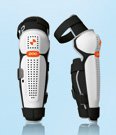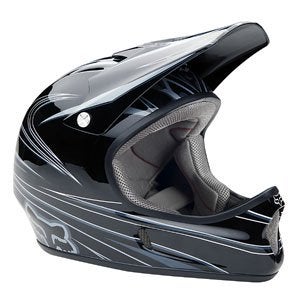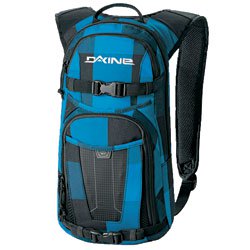*Or at least look like one…
Coming off a slew of big mountain skiing injuries, I needed to find a way to train in summer and to reinject some athletic purpose in my life. So, I decided to try some downhill mountain biking with the goal of entering some races. Although it looks suspiciously like a motor-cross invasion of the mountain bike scene, downhill mountain biking is actually pretty easy to A) get involved in, and B) get addicted to. Yes, all that armor looks intimidating , but the riders are actually just smiling under their full-face helmets. Trust me.
For those of us who can do without the climb, and prefer adrenalin to endorphins, this is a great time to get into downhill specific biking. The equipment and protection get better every year. More and more DH trails are being built across the country. More and more ski resorts are offering lift-accessed DH trails. Perched on these big bikes at the top of trails are armor-clad couples, groups of girls, tourists, parents, children. Again, it's because under all the armor, it's really, really fun.
Like most really fun sports, DH biking involves considerable gear. If you think you can get away without itÔÇö some of it you can, some you shouldn'tÔÇöremember that the gear can help keep you on the hill instead of at home considering skin grafts or watching bones heal. WhichÔÇötrust meÔÇöis not so much fun.
With that said, here's a list of a few things, more or less in order of necessity, that you should get. That is, if you want to skip that miserable upclimb, join the group speeding maniacally down, and hit lap after lap of features.
1. BODY ARMOR: ╠řAccording to Andy Olpin, owner of who oversees the fast-growing DH biking scene in Jackson Hole, WY from his bike shop at the base of Teton pass, armor is the most important type of gear. “It'll save you if you roll through rocks….hopefully you can just dust yourself off and keep riding..”

These POC Joint VPD elbow pads, made of a visco polymer dough, are flexible but harden upon impacts. It's nice because you won't feel them as much, but can be confident that they are protecting your joints.
 ╠ř
╠ř
Full-fingered gloves are key in DH biking. When you fly off your bike, and you will, you'll want your hands protected against the dirt, rocks, bike, and trees. ╠řSome gloves offer padding and extra armor on your hands, but coverage of your whole hand is really the key here. ╠ř

2. ╠řFULL-FACE HELMET
A close second after armor importance is the full-face helmet. It's not just for looking like you know what you are doing. Olpin, who has observed many mishaps offers this helpful impetus for purchase. “These help keep your face out of the dirt and rocks; and you can keep your teeth.”
Enough said. My helmet from╠řfits my head perfectly, although you should try a on a few brands to find the best match for your noggin.╠ř

3. VISION PROTECTION: A lot of riders wear goggles with their helmets, often moto-cross or DH specific versions. ╠řThese keep the dust and wind out, and offer tear-away options, in case you are racing in bad weather. Some people use ski goggles, or sunglasses. The nice thing about moto goggles, like the , is that the rubber grips on the strap keep them securely in place on your helmet. ╠ř(No one wants goggles falling off while ridingÔÇöyou don't want to actually put your full-face to use, do you?)

4. FOOTWEAR: ╠řMost DH riders use flat pedals, and avoid clipped-in set-ups. It's nice to be able to get your foot out on sharp corners or sketchy sections. Orr, as a racer friend of mine points out; you want to be able to get away from the bike if you crash, since just about everything is softer than the bike. ╠řDH or freeride specific shoes like these from ╠řhave support, plus sticky rubber soles to help grip the pedals.

5. THE PACK: ╠řNow, you need something to lug your armor to the trails in, keep some water, layers, first aid supplies, and tools in. Any backpack should do, but those built for DH, like this ╠řpack provide specific straps and compartments to keep everything organized.

After you're geared up, all that is left is to take a deep breath and drop in.╠ř╠ř
I'll return next week with some riding technique tips from the pros.
—